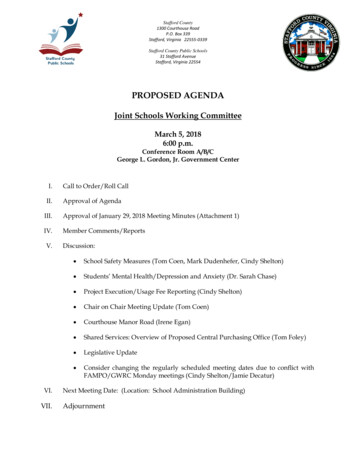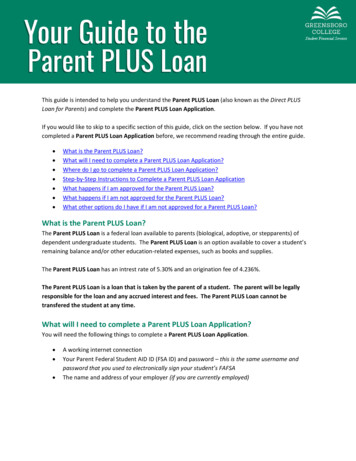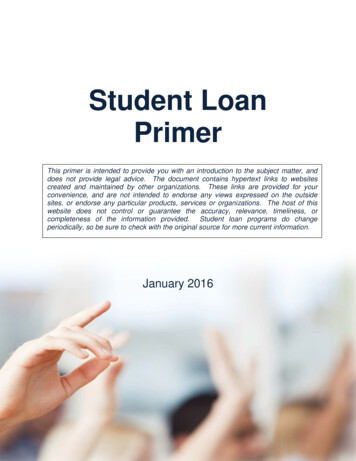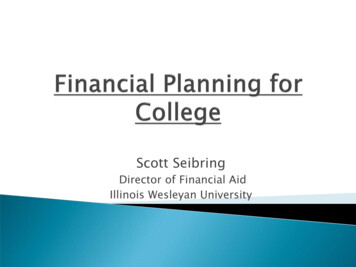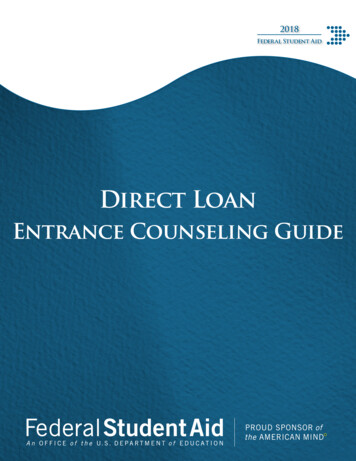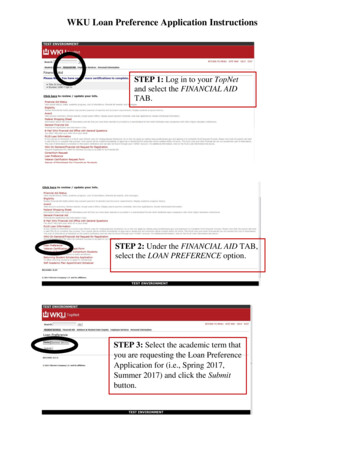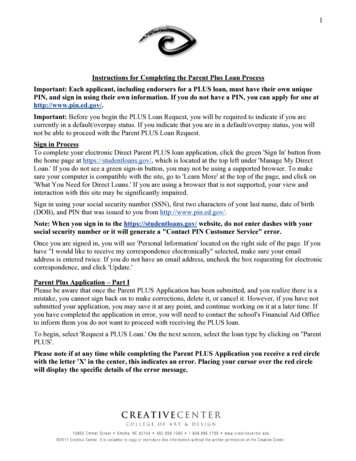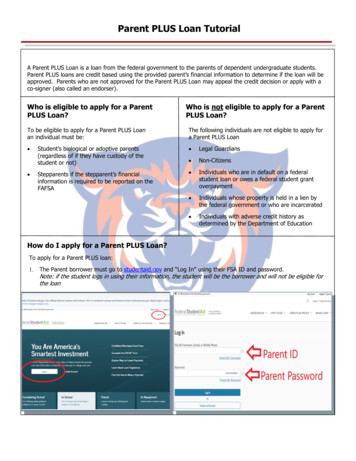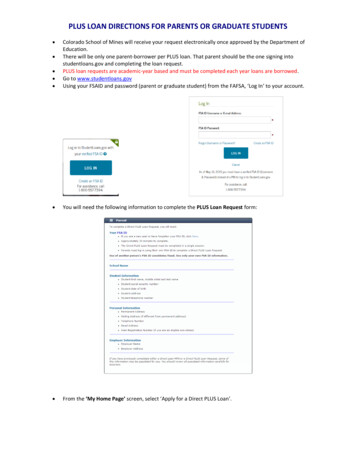
Transcription
Stafford/PLUS LoanPeriods and Amounts4CHAPTERThe rules for awarding Stafford and PLUS loans are different than for Pell Grants and otherFSA programs. Annual loan limits vary by grade level, and there are aggregate limits on thetotal amount that may be borrowed at one time. Also, the “loan period” and the disbursementswithin that period may not always correspond to the payment periods that you’re using for PellGrants. Finally, the requirement to prorate Stafford loan limits is different than the requirementsfor calculating Pell Grants.The student’s eligibility for a Stafford Loan (and a parent’seligibility for a PLUS Loan) is calculated differently than the PellGrant. There is no fixed table such as the Pell Grant Payment andDisbursement Schedules that determines award amounts. StaffordLoans have annual and aggregate limits that are the same for allstudents at a given grade level and dependency status. This chapter willdescribe these loan limits and how they apply to the academic year indifferent types of programs.Since you must determine a student’s eligibility for Stafford andalso a parent’s eligibility for PLUS in combination with other sourcesof aid, we’ll discuss this topic in further detail in Chapter 6 onpackaging.CHAPTER 4 HIGHLIGHTS:Measurements of academic andloan periods Loan periods, academic terms, & program length Scheduled Academic Year (SAY) may be used for credithour programs with standard terms. Borrower-Based Academic Year (BBAY) may be used asan alternative to an SAY for standard term credit-hourprograms also offered in an SAY BBAY must be used for clock-hour, nonterm, andnonstandard term programs, and for standard term credithour programs without an SAY.Annual Loan LimitsLOAN PERIODS, ACADEMIC TERMS, & PROGRAMLENGTHIt’s important to define the loan period (sometimes referred to asthe period of enrollment) at the outset, because the length of the loanperiod will determine the timing and amount of disbursements. Thisdiscussion assumes that your school has already established itsacademic measurements. If you have not already done so, see Chapter1 for a discussion of eligible programs, academic years, paymentperiods, and conversion of clock hours/credit hours.If a program uses standard terms, such as semesters, trimesters, orquarters, the loan period may coincide with one or more of itsacademic terms. The minimum loan period is a single academic term.(For a discussion of academic terms as used in awarding aid, seeVolume 3, Chapter 3.) As an example, if a student will be enrolled inthe fall semester only and will skip the spring semester, you may certifya loan for that term alone. (Remember, however, that the loanamount must be based on the reduced costs and EFC for that term,rather than for the full academic year.) Stafford limits for dependent undergraduates Stafford limits for independent undergraduates &dependent undergraduates whose parents can’t get PLUS Undergraduate limits based on grade level Undergraduate limits must be prorated for programsless than an academic year or remaining portion of aprogram less than an academic year Stafford limits for graduate and professional students Stafford limits for teacher certification courseworkAggregate Loan Limits Loan information provided through“Financial Aid History” on SAR, ISIR, and on NSLDS Web site. NSLDS now identifies underlying amounts for FFEL aswell as Direct Consolidation Loans.FSA Handbook 3–65
Vol. 3 — Calculating Awards & Packaging, 2006-07Period of enrollment (loanperiod)The period of enrollment for which a Stafford or PLUS loan isintended.The period of enrollment must coincide with anacademic period established by the school for whichinstitutional charges are generally assessed (e.g., semester,trimester, quarter, length of the student’s program oracademic year).The period of enrollment is also referred to asthe loan period.34 CFR 682.200(b)34 CFR 685.102(b)Minimum and Maximum LoanPeriods Maximum generally school’s academic year but notmore than 12 months. Minimum (standard term programs) one academicterm Minimum (clock-hour, nonterm, and nonstandardterm programs) lesser of academic year, program length,or remaining portion of academic programAcademic YearSee Volume 3, Chapter 1 for a discussion of academic yearrequirements.Simultaneous FFEL and DLA school may simultaneously participate in both the FFELand DL programs, but student or parent borrowers maynot receive both a DL and an FFEL loan for the sameperiod of enrollment.34 CFR 685.300(a)(8)Stafford/PLUS at multiple schoolsUnlike Pell Grants, it is possible for a student who isseparately enrolled and eligible at multiple schools to get aStafford (and the parent to receive a PLUS) at more than oneschool for the same period.The schools that the student isattending are responsible for coordinating to make sure thatthe total amount of the loans the student receives does notexceed the applicable annual loan limit. In addition, theschools must ensure that there is no duplication of noninstitutional costs when determining the student’s cost ofattendance. (Note that loan funds awarded at one schoolare not to be included as estimated financial assistanceby any other school the student is attending whendetermining the student’s loan eligibility for the sameperiod.)3–66FSA HandbookLoan periods for all other programs, such as nonterm ornonstandard term programs, are based on the length of the program orthe length of the Title IV academic year. These loan periods also apply toprograms that are a mixture of standard terms and nonstandard termsnot offered in a traditional academic calendar. The minimum loanperiod for such programs is the shortest of: The Title IV academic year as defined by the school. (At least 30weeks of instructional time and, for undergraduate programs, at least900 clock hours, 24 semester hours, or 36 quarter hours.) The length of the student’s program at the school for programs of lessthan an academic year. The remaining portion of the student’s program when the programexceeds the academic year.The maximum loan period is generally the school’s academic yearbut cannot exceed a 12-month period. However, you can have morethan one loan in an academic year up to the annual loan limit.ACADEMIC YEAR & LOAN LIMITSThe academic year is used as the basis for the student’s annualloan limits. (The award year concept for Pell and the Campus-basedprograms is not a factor for Stafford and PLUS loans.)Depending on the program, a student who has reached the annualloan limit cannot receive another Stafford Loan until he or she eitherbegins another academic year, or progresses within an academic yearto a grade level with a higher annual loan limit.The loan period is often equivalent to an academic year, but thereare also many situations where this is not the case. In this section, we’lldiscuss how you can match the student’s loan periods to his/herenrollment and your school’s academic calendar. (If you are notfamiliar with the definition of an academic year, see Chapter 1 of thisVolume.)Two types of academic years for annual loan limits: SAY andBBAYThere are two types of academic years that may be used to monitorannual loan limits for Stafford loans: a Scheduled Academic Year(SAY) or a Borrower-Based Academic Year (BBAY). (Note thatalthough there is no annual loan limit for PLUS loans, PLUS loansare awarded for the same SAY or BBAY period that is used forStafford loans.) An SAY corresponds to a traditional academic yearcalendar that is published in a school’s catalogue or other materials(for example, fall and spring semesters, or fall, winter, and springquarters). An SAY is a fixed period of time that begins and ends at thesame time each year. A BBAY does not have fixed beginning andending dates. Instead, it “floats” with a student’s (or group ofstudents’) attendance and progression in a program of study.
Ch. 4: Stafford/PLUS Loan Periods and AmountsStandard term, credit hour programs that are offered in an SAY(that is, a traditional academic year calendar) also have the option ofusing a BBAY. Standard term, credit hour programs that are notoffered in an SAY must use a BBAY. Clock-hour, nonterm, andnonstandard term programs must also use a BBAY. However, there aresignificant differences between the BBAY for standard term, credithour programs, and the BBAY for clock-hour, nonterm, andnonstandard term programs.Standard term, credit hour programs using a traditionalacademic year calendar: Scheduled Academic YearAs noted above, an SAY corresponds to a traditional academic yearcalendar, and usually begins and ends at the same time each calendaryear (for example, beginning on the first day of the fall semester andending on the last day of the spring semester). An SAY may includeone or more terms that a student does not attend. Summer terms aregenerally not considered to be part of the SAY, but for loan limitpurposes they may be treated as “trailers” or “headers” to the SAY, asexplained below. An SAY must meet the Title IV requirements for anacademic year, as described in Chapter 1.For loan limit purposes, a summer term may be treated as a“trailer” to the preceding SAY or as a “header” to the following SAY.Summer mini-sessions can be grouped together as a single trailer orheader term, or they can be treated separately and assigned todifferent SAYs. (See Chapter 1 and 3 for treatment of mini-sessions aspayment periods and in determining Pell payments.) If the summermini-sessions are grouped and treated as a single term, the summercost of attendance cannot include costs for a mini-session for whichthe student is not expected to be enrolled.Your school has the option to establish a policy that designates itssummer term as either a trailer or header to the SAY for all students.You can also choose to make different designations for differenteducational programs, or for different students, as long as you ensurethat there is no overlap in academic years. Note that a fixeddesignation of the summer term can limit a student’s eligibility. Forinstance, if you always treat your summer term as a trailer to apreceding fall-spring SAY, a student who receives the full annual loanlimit for fall-spring would have no remaining loan eligibility forsummer.The annual loan limit applies to the SAY, plus the summer traileror header. Once the calendar period associated with all of the terms inthe SAY and the summer header or trailer (if any) has elapsed, astudent regains eligibility for a new annual loan limit.Standard term, credit hour programs using a traditionalacademic year calendar: Borrower-Based Academic YearIf a standard term, credit hour program is offered in a traditionalacademic year calendar (SAY), you have the option of using a BBAY asan alternative to the SAY for monitoring annual loan limits for anindividual student. Unlike an SAY, a BBAY is not a fixed period thatFSA Handbook 3–67
Vol. 3 — Calculating Awards & Packaging, 2006-07begins and ends at the same time each year. Instead, a BBAY’sbeginning and ending dates depend on the individual student’senrollment.For standard term, credit hour programs offered in a traditionalacademic year calendar, a BBAY must include the same number ofterms as the SAY that would otherwise be used (not including anysummer “trailer” or “header”). For example, if the SAY includes threequarters (fall, winter, spring) a BBAY would consist of any threeconsecutive terms. A BBAY may include terms the student does notattend if the student could have enrolled at least half time in thoseterms, but (unlike an SAY) it must begin with a term in which thestudent is actually enrolled. Also, any mini-sessions (summer orotherwise) that run consecutively within a term must be combined andtreated as a single term. Like an SAY, a BBAY must meet the minimumTitle IV requirements for an academic year. However, a BBAY thatincludes a summer term may include fewer than 30 weeks ofinstructional time or fewer credit hours than the minimum numberrequired for an SAY. This is because a summer term may be shorterthan a standard term in a SAY, but is recognized as academicallyequivalent to a standard term when used as one of the terms in aBBAY. (NOTE: This exception applies only to a BBAY used as analternative to an SAY for a standard term, credit hour program that isalso offered in a traditional academic year calendar.)You may use BBAYs for all students, only for students in certainprograms, or on a student-by-student basis. For example, you could usea BBAY for students enrolled in a program that begins in a term otherthan the first term of the SAY. You can even alternate BBAYs and SAYsfor a student, provided the academic years don’t overlap. Thistreatment may allow a student to receive another loan sooner thanwould be allowed under an SAY standard. For instance, if you normallyuse an SAY consisting of Fall and Spring semesters with a Summertrailer, a student who received the maximum annual loan limit for FallSpring could not receive another loan until the start of a new SAY inthe Fall. If the student enrolls for summer and wants a loan, you couldchoose to switch the student to a BBAY consisting of the Summer andFall terms. The student could then receive a loan for the Summerterm, since Summer would be the start of a new academic year. Aschool that has these choices for academic year standards must have awritten policy that explains how it applies these options whencalculating loan eligibility.As with a SAY, the annual loan limit applies to the BBAY. Once thecalendar period associated with all of the terms in the BBAY haselapsed, a student regains eligibility for a new annual loan limit.Standard term, credit hour programs not using a traditionalacademic year calendar: Borrower-Based Academic YearIf a program is not offered in a traditional academic year calendar(SAY), a BBAY must be used. If the program uses semesters ortrimesters, a BBAY generally consists of any two consecutive terms. Ifthe program uses quarters, a BBAY consists of any three consecutive3–68FSA Handbook
Ch. 4: Stafford/PLUS Loan Periods and Amountsterms. As with the optional BBAY that may be used for programsoffered in a traditional academic year calendar, the BBAY may includeterms that a student does not attend (as long as the student could haveenrolled at least half-time in those terms), but it must begin with aterm in which the student is actually enrolled. Unlike the optionalBBAY for programs offered in an SAY, there is no exception to theminimum Title IV academic year requirements for a BBAY thatincludes a summer term: the BBAY for programs that are not offeredin a traditional academic calendar must always include enough termsto meet the minimum Title IV academic year requirements for weeksof instructional time.The annual loan limit applies to the BBAY. Once the calendarperiod associated with all of the terms in the BBAY has elapsed, astudent regains eligibility for a new annual loan limit.Clock-hour, nonterm credit-hour, and nonstandard term credithour programs: Borrower-Based Academic YearAll clock-hour, nonterm, and nonstandard term programs mustuse a BBAY that meets the minimum Title IV requirements for anacademic year. This requirement also applies to programs that consistof both standard and nonstandard terms and that are not offered in atraditional academic calendar. That is, the BBAY must contain at leastthe number of weeks of instructional time and hours in the program’sTitle IV academic year. The Title IV academic year must contain atleast 30 weeks of instructional time and the appropriate number ofcredit or clock hours (for undergraduate programs, at least 24semester or trimester hours, 36 quarter hours, or 900 clock hours; forgraduate programs, the number of hours a student would completeunder the school’s full-time standard in the weeks of the Title IVacademic year, which must be a minimum of 30 weeks.) The BBAYbegins when a student enrolls and does not end until the student hascompleted the number of hours and the number of weeks in theacademic year.Because a student must successfully complete the minimumnumber of hours and weeks in an academic year before a new BBAYbegins, a student’s enrollment status may affect how soon the studentregains eligibility for a new annual loan limit. For example, a studentwho is attending part-time will take longer to complete a BBAY than afull-time student. (In contrast, an SAY or BBAY for a standard term,credit hour program ends when the calendar period associated with theterms in the SAY or BBAY has elapsed, regardless of how many credithours or weeks of instruction the student completed during the SAY orBBAY.)Clock-hour, nonterm andnonstandard BBAYs based onfull-time progressIn many clock-hour, nonterm and nonstandard termprograms, students are allowed to progress at an individualpace. For example, a school that defines its academic year as900 clock hours and 30 weeks of instructional time offers a900 clock-hour program that most students complete in 30weeks. However, one student might complete 900 clockhours in 26 weeks, and another in 34 weeks.You do nothave to prorate the loan limit for the occasional student whocompletes the program in less than 30 weeks. (Note thatthis policy applies only to programs that are exactly oneacademic year in length. If a program is longer than anacademic year, proration may be required for a loancovering the remaining portion of the program if astudent completes more than the minimum number ofhours during the first 30 weeks of instructional time. Seeloan limit proration example #3 on p. 3-81.FSA Handbook 3–69
Vol. 3 — Calculating Awards & Packaging, 2006-07Standard Term, Credit Hour Programs using atraditional academic year calendar: SAYThe Springfield Academy offers a two-year program measured in semesters and awarding credit hours. It defines its Title IV academic year inaccordance with the minimum requirements and uses an SAY that provides 30 weeks of instruction and 24 semester hours, and includes twosemesters (Fall and Spring), each 15 weeks of instructional time in length. Springfield Academy also offers a Summer session that it treats as a “trailer”to the SAY.Most of Springfield’s students do not attend the Summer session, so the aid office typically certifies Stafford loans for a period of enrollment that startswith the Fall semester (August 27) and concludes at the end of the Spring semester (May 2). However, there are some first-year students who decideto enroll in the Summer term in order to complete their studies sooner. The annual loan limit applies to the Fall-Spring SAY, plus the Summer trailer.Students who receive the maximum annual loan amount for Fall-Spring have no loan eligibility for summer and may not borrow again until the startof the next SAY in the Fall.Academic Year for loan limit purposes 2 semesters summer trailerFallSpringSummerYear 1: SAY Summer TrailerYear 2: SAY Summer TrailerClock-hour, Nonterm, and Nonstandard Term program: BBAYExample 1: Clock-hour ProgramSpringfield Academy has an 1800 clock-hour program with 60 weeks of instructional time, and defines its academic year as 900 clock hours and 30 weeks ofinstructional time. The BBAY always begins with the student’s actual enrollment date. An enrolling student may receive two Federal Stafford Loans during theprogram (provided all eligibility criteria are met) because the program exceeds one academic year. The period of enrollment for the first loan would be the timeit will take the student to successfully complete (pass) 900 clock hours and 30 weeks. The period for the second loan would be the time it takes to successfullycomplete the final 900 hours/30 weeks. Note that the student cannot receive the second loan until he/she has successfully completed the first 900 hours of theprogram AND 30 weeks of instruction.A student who completes the first 900 hours in less than 30 weeks must still complete 30 weeks of instructional time before a new BBAY begins and thestudent becomes eligible to receive another loan. Similarly, a student who has completed fewer than 900 clock hours after 30 weeks of instructional time mustsuccessfully complete 900 hours before receiving another loan.Example 2: Nonterm credit hour programA school offers a 48-semester hour program with a defined academic year of 24 semester hours and 30 weeks of instructional time. As with the clock-hourprogram in example 1, a student could receive two loans for this program. The period of enrollment for the first loan would be the time needed for a student tosuccessfully complete the first 24 hours and 30 weeks of instructional time. The period of enrollment for the second loan would be the time needed to completethe remaining hours and weeks of the program. A student must successfully complete (pass) both 24 semester hours AND 30 weeks of instructional time beforereceiving the second loan.Example 3: Nonstandard term, credit hour programA school offers a 72-quarter hour program with 60 weeks of instructional time and a defined academic year of 36 quarter hours and 30 weeks of instructionaltime. Courses are offered in 5-week terms; a full-time student would be expected to complete six quarter hours in each term. As with examples 1 and 2, astudent could receive two loans, one for the first 36 hours and 30 weeks, and another for the remaining hours and weeks of the program.Although this program uses terms and measures academic progress in credit hours, the terms are nonstandard terms. A student does not become eligible forthe second loan until he or she has completed both 36 quarter hours and 30 weeks of instructional time, regardless of the number of terms that have elapsed.For instance, a student who completes six quarter hours during each of the first five terms of the program, but only successfully completes (passes) threequarter hours of the six quarter hours in the sixth term, must complete an additional three quarter hours before receiving the second loan.3–70FSA Handbook
Ch. 4: Stafford/PLUS Loan Periods and AmountsStandard Term, Credit-Hour programs using a traditional Academic Yearcalendar: BBAYExamples 1a through 1c illustrate the optional use of a BBAY for a program that is offered in an SAY consisting of two semesters, Fall andSpring, each 15 weeks of instructional time in length. (Note that in each example, the first BBAY is the same as the SAY.)In example 1a, the initial Fall and Spring terms could beconsidered either an SAY or BBAY. If the student attends theSummer session at the school, the aid administrator can elect totreat the Summer term and the next Fall as a BBAY for thestudent. In that case, the following Spring and Summer wouldalso constitute a BBAY. The maximum loan limit for an academicyear applies to each BBAY. If these were the first three years ofstudy for a dependent student and the student progressed agrade level each academic year, he/she would be eligible for up tothe maximum Stafford amounts of 2,625, 3,500, and 5,500 forthe respective academic years.A student doesn’t have to attend all of the termsin a BBAY, but the BBAY cannot begin with a termthat the student doesn’t attend. In example 1b,the student is not enrolled in the second term(Fall) of BBAY #2. In example 1c, if the studentdoes not attend a term that otherwise would havebeen the beginning of a BBAY (in this case,Spring), then the student’s next BBAY cannotbegin until the next term that the studentattends. As with example 1a, the annual loan limitapplies to each BBAY.The same concepts apply to quarter-term programs.For instance, in example 2, the Fall, Winter, andSpring terms constitute the school’s SAY. If thestudent attends the Summer session at the school,it can be the first term of a BBAY that includes thefollowing Fall and Winter terms1. BBAY where SAY contains 2 semesters1a.FallSpring Summer FallYear 2: BBAYSummerSpringYear 3: BBAYYear 3: BBAYSpring Summer FallSpring SummerYear 1: SAY or BBAY1b.Fall(not enrolled)Year 1: SAY or BBAYSpring Summer FallFall1c.Year 3: BBAYYear 2: BBAYSpring SummerFall(not enrolled)Year 1: SAY or BBAYYear 3: BBAYYear 2: BBAY2. BBAY where SAY contains 3 quartersFallWinter SpringSummerYear 1: SAY or BBAYFallWinterYear 2: BBAYStandard Term, Credit-Hour programs not using a traditional AcademicYear calendar: BBAYSpringfield Academy also has a program that measures academic progress in credit hours and uses 15-week semesters, but is not offeredin a traditional academic year calendar (SAY). New students begin the program each month, and a 15-week semester begins at that timefor that cohort of students. The school must use a BBAY to monitor annual loan limits. A BBAY consists of any two consecutive semesters,beginning with a semester in which a student is enrolled:Semester #1Semester #2(begins program)Year 1: BBAYYear 1: BBAYSemester #4(not enrolled)Year 2: BBAYSemester #3Year 2: BBAYSemester #5Semester #6Year 3: BBAYYear 3: BBAYFSA Handbook 3–71
Vol. 3 — Calculating Awards & Packaging, 2006-07ANNUAL LOAN LIMITSStafford Loans have annual loan limits, based on the student’sdependency status and grade level. There are higher unsubsidizedStafford annual loan limits for some health professions students, andspecial loan limits for certain students who are not enrolled in adegree or certificate program. In some cases, the annual loan limitsmust be prorated (reduced). The annual loan limits are the maximumamounts that a student may receive for an academic year.Stafford limits for an undergraduate studentThe annual loan limits for an undergraduate student increasefrom 2,625 for a first-year student, to 3,500 for a second-year student, to 5,500 for a third-, fourth-, or fifth-year undergraduate. These loan limitsrepresent the total of all subsidized and unsubsidized Stafford Loans adependent undergraduate student may borrow at each level of study,for a single academic year.Example: additional unsub forindependent undergraduateDottie is a first-year independent undergraduate student atFerrar’s Institute. Her COA is 9,500, her EFC is 1,800, andshe is receiving a 2,000 Pell Grant. Dottie qualifies for asubsidized Stafford Loan of 2,625. She may also receive themaximum additional unsubsidized Stafford Loan amountof 4,000 ( 3,075 to cover her unmet need, plus 925 toreplace a portion of the EFC). Her total loan amount insubsidized and unsubsidized Stafford Loans is 6,625.Increased unsubsidized Stafford limits for independent studentsand dependent students whose parents can’t get PLUSIndependent undergraduate students may borrow unsubsidizedloans with additional loan limits. The additional loan limits also applyto dependent undergraduate students whose parents are unable toborrow PLUS loans due to adverse credit or other documentedexceptional circumstances.The following unsubsidized loan amounts may be added to theborrower’s combined subsidized and unsubsidized loan limits. Anindependent undergraduate student enrolled in a program of studythat is at least an academic year in length may borrow additionalunsubsidized loan amounts not to exceed an annual total of—Subsidized and unsubsidizedloans up to 4,000 for a first- or second-year student,There are two types of loans in the Stafford program:subsidized and unsubsidized.The federal government paysthe interest on a subsidized student loan during in-schoolstatus, the grace period, and during authorized defermentperiods.The student is responsible for paying the intereston an unsubsidized student loan during all periods. up to 5,000 for a third-, fourth-, or fifth-year undergraduate.The subsidized portion of the annual loan limit may not exceedthe overall annual loan limit for a dependent student. For example, anindependent student in the second year of study would be eligible toborrow a total of 7,500 in subsidized and unsubsidized Stafford loans,but no more than 3,500 of this total may be in the form of asubsidized Stafford loan.Grade level progression between different academic yearsAs shown above, the annual loan limit for Stafford Loans increasesas a student progresses in his/her studies. Generally, a student’s gradelevel for loan limit purposes is set according to the school’s academicstandards. Note that progression to a higher grade level does notalways coincide with the beginning of a new academic year for loanlimit purposes. For example, a student in a standard term, credit hourprogram using semesters who completes only 12 semester hoursduring the first academic year of a 2-year program could receiveanother loan when the calendar period associated with that academic3–72FSA Handbook
Ch. 4: Stafford/PLUS Loan Periods and Amountsyear has elapsed, but the student will still be classified as a first-yearundergraduate at the start of the second academic year.In contrast, progression to a higher grade level and the beginningof a new academic year for loan limit purposes always happen at thesame time for a student in a clock-hour, nonterm or nonstandard termprogram. A student who is enrolled in such a program mustsuccessfully complete the weeks and hours in the program’s Title IVacademic year, i.e., at least 30 weeks of instructional time and theacademic credit, in order to advance to the next grade level. Forinstance, a first-year student in a 2-year nonterm program who earns 36quarter-credits over 24 weeks of instructional time cannot progress tothe next grade level until another 6 weeks of instructional time arecompleted.Additional Unsubsidized StaffordDependent students whose parents are unable to borrow PLUS loans dueto adverse credit or other exceptional circumstances may receiveadditional unsubsidized Stafford loan amounts at the same level asindependent undergraduate students. The increased loan amounts donot substitute entirely for the amount a parent may borrow under thePLUS program, which may be up to the difference between COA and EFA.As a result, you should examine the p
The student's eligibility for a Stafford Loan (and a parent's eligibility for a PLUS Loan) is calculated differently than the Pell Grant. There is no fixed table such as the Pell Grant Payment and Disbursement Schedules that determines award amounts. Stafford Loans have annual and aggregate limits that are the same for all
